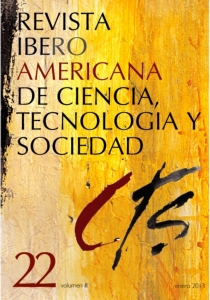The Structure of Scientific Revolutions
fifty years down the road
DOI:
https://doi.org/10.52712/issn.1850-0013-662Keywords:
scientific community, paradigm, pluralism, incommensurability, technoscienceAbstract
The Structure of Scientific Revolutionswas definitely one of the most influential books of the 20th century. To commemorate the 50th anniversary of its first publication, this article reviews the validity of some of the central concepts of this book. Even though -as it has been stated several times- these concepts have not all the originality that they initially seemed to possess, they have nevertheless exerted a decisive influence on the reflection on science in the second half of the last century. These concepts are those of “scientific community”, “paradigm”, “paradigm shift” and “incommensurability”. The latter one has generated many implications in terms of the incommensurability between paradigms and between worlds, and therefore it has brought many changes to the pluralistic conceptions of epistemology and ontology. This article concludes with a review of some limitations that the Kuhnian conceptual apparatus encounters nowadays in order to account for the scientific activity that came after the development, proliferation and predominance of technoscientific systems over and above scientific systems as we knew them since their emergence in the scientific revolution of the 17th century, and their development during the 18th, 19th and 20th centuries.
Downloads
References
BOYD, R. (1992): “Constructivism, realism and philosophical method”, en J. Earman (ed.): Inference, Explanation and other Frustrations,Berkeley, University of California Press, pp. 131-198.
BUNGE, M. (1996): Ética, Ciencia y Técnica, Buenos Aires, Editorial Sudamericana.
COEN, D. R. (2012): “Rise, Grubenhund: on provincializing Kuhn”,Modern Intellectual History,vol. 9, pp 109-126
COLLINS, H. (2012): “Comment on Kuhn”, Social Studies of Science, vol.42, nº 3, 420-423.
ECHEVERRÍA, J. (1995): Filosofía de la Ciencia,Madrid, Ediciones Akal.
ECHEVERRÍA, J. (2002): Ciencia y Valores,Barcelona, Ed. Destino.
ECHEVERRÍA, J. (2003): La Revolución Tecnocientífica,Madrid, Fondo de Cultura Económica.
FLECK, L. (1935): Entstehung und Entwicklung einer wissenschaftlichen Tatsache. Einfu_hrung in die Lehre vom Denkstil und Denkkollektiv,Basilea, Schwabe und Co.
FLECK, L. (1979): La génesis y el desarrollo de un hecho científico,Madrid, Alianza Editorial, 1986.
FRIEDMAN, M. (2012): “Kuhn and Philosophy”, Modern Intellectual History,vol. 9, nº 1, pp. 77-88.
GORDON, P. E. (2012): “Forum: Kuhn’s Structure at fifty, Introduction”, Modern Intellectual History, vol. 9, pp 73-76.
HACKING, I. (2012): “Introductory Essay to The Structure of Scientific Revolutions, 50th Anniversary Edition”, Chicago,University of Chicago Press.
KEISER, D. (2012): “In retrospect The Structure of Scientific Revolutions”, Nature,vol. 484, p. 183.
JASANOFF, S. (2012): “Genealogies of STS”, Social Studies of Science,vol. 42, nº 3, pp. 435-441.
KUHN, T. (2012): The Structure of Scientific Revolutions: 50th Anniversary Edition, University of Chicago Press. Traducción española: La Estructura de las Revoluciones Científicas, traducción de Carlos Solís, segunda edición, Fondo de Cultura Económica, México, 2004.
KUHN, T. (1977):The Essential Tension,The University of Chicago Press. Traducción al español: La Tensión Esencial, México, Fondo de Cultura Económica, 1982.
KUHN, T. (1982): “Commensurability, Comparability, Communicability”, PSA Proceedings of the Biennial Meeting of the Philosophy of Science Association,Volume Two: Symposia and Invited Papers, pp. 669-688.
KUHN, T. (1991): “The road since Structure”, PSA, vol. 2, pp. 3-13, Philosophy of Science Association.
LAKATOS, I. y MUSGRAVE, A. (1970): Criticism and the Growth of Knowledge, Cambridge University Press.
MASTERMAN, M. (1970): “The Nature of a Paradigm”, en I. Lakatos y A. Musgrave (1970): Criticism and the Growth of Knowledge, Cambridge, Cambridge University Press, pp. 59-89.
MERTON, R. K. (1942): “The normative structure of science” (publicado originalmente como “Science and Technology in a Democratic Order”), en R. K. Merton (1973), pp. 267-278.
MERTON, R. K. (1973): The Sociology of Science, Theoretical and Empirical Investigations,Chicago y Londres, The University of Chicago Press.
MULKAY, M. (1980): “Interpretation and the use of rules: the case of the norms of science”, en T. F. Gieryn (ed.): Science and Social Structure: AFestschrift for Robert K. Merton,Transactions of The New York Academy of Sciences, series II, vol. 39, pp. 111-125.
OLIVÉ, LEÓN (2007): La ciencia y la tecnología en la sociedad del conocimiento, México, Fondo de Cultura Económica.
OLIVÉ, LEÓN (2012ª): El Bien, El Mal y La Razón. Facetas de la ciencia y la tecnología,(2a ed.), México, UNAM.
OLIVÉ, LEÓN (2012b): Multiculturalismo y Pluralismo(2a ed.), México, UNAM.
PÉREZ RANSANZ, A. R. (1999): Kuhn y el cambio científico, México, Fondo de Cultura Económica.
PÉREZ RANSANZ, A. R. y VELASCO, A. (2011): Racionalidad en ciencia y tecnología. Nuevas perspectivas iberoamericanas,México, UNAM.
POPPER, K. (1972): “Epistemology Without a Knowing Subject”, Objective Knowledge. An Evolutionary Approach,Oxford, Clarendon Press.
PUTNAM, H. (1987): The Many Faces of Realism,Open Court, Lasalle, Ill.
PUTNAM, H. (1990): Realism with a Human Face, Cambridge, Harvard University Press.
REISCH, G. (1991): “Did Kuhn Kill Logical Empiricism?”, Philosophy of Science,vol. 58, pp. 264-77.
RESCHER, N. (1993): Pluralism,Oxford, Oxford University Press.
VARGAS, R. (2012): “Cómo (casi) perder un clásico”, La Gaceta del Fondo de Cultura Económica,nº 501, p. 13.
WINCH, P. G. (1958): The Idea of a Social Science,Londres, Routledge and Kegan Paul.
Downloads
Published
How to Cite
Issue
Section
License
Copyright (c) 2024 CC Attribution 4.0

This work is licensed under a Creative Commons Attribution 4.0 International License.
All CTS's issues and academic articles are under a CC-BY license.
Since 2007, CTS has provided open and free access to all its contents, including the complete archive of its quarterly edition and the different products presented in its electronic platform. This decision is based on the belief that offering free access to published materials helps to build a greater and better exchange of knowledge.
In turn, for the quarterly edition, CTS allows institutional and thematic repositories, as well as personal web pages, to self-archive articles in their post-print or editorial version, immediately after the publication of the final version of each issue and under the condition that a link to the original source will be incorporated into the self-archive.











